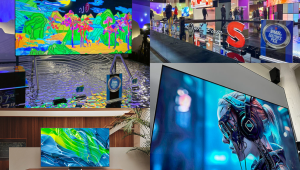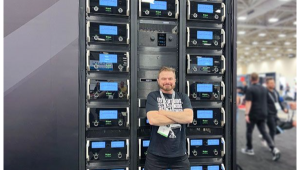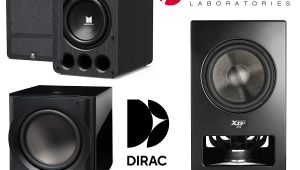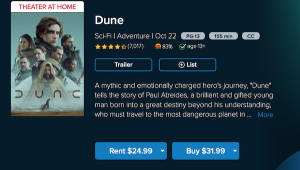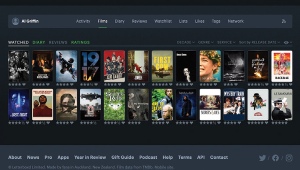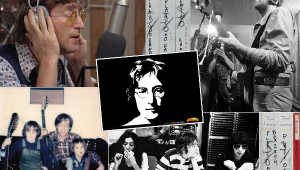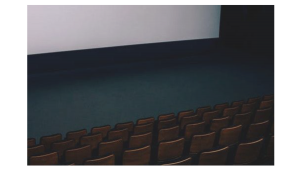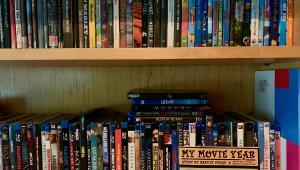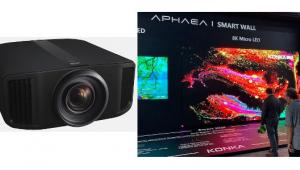You're still sulking round?? Another last word freak. Go away dick#1. If this mag sinks, it's because of narcissists like you.
Where Have All the Audiophiles Gone?
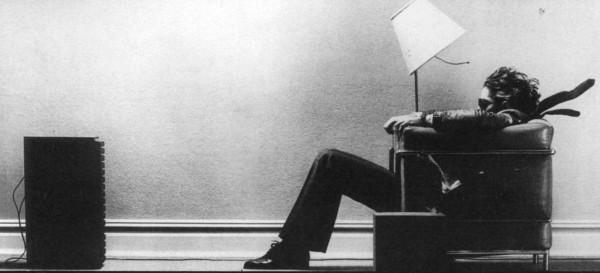
In response to Thiel’s question, our resident audio historian and audio technical editor Mark Peterson reminds us that the tape loop and pre-out/main-in connections required to hook up even a stereo (much less multichannel) equalizer or other processor disappeared with the advent of multichannel AV receivers, well before built-in DSP and automated room correction came into vogue. It was, he suggests, a financial decision by manufacturers seeking to save cost and back-panel real estate. So this might have been something of a chicken-and-egg situation: Did the demand for equalizers (or home recording) disappear first, followed by the removal of the connectors? Or did the manufacturers’ decision to provide the clearly desirable benefit of surround sound in competitively priced products simply require triage of more esoteric functions (like the hookup of an equalizer or tape deck), and thereby hasten the disappearance of these products?
On the idea that audio manufacturers don’t arbitrarily bite the hand that feeds, we might rightfully assume that sales of these accessory products were waning enough by the time they canned the jacks to suggest that the general public would not miss the lack of connection points. So that got me wondering: When exactly did we, as a nation of music lovers, stop wanting to tweak and tailor our sound to make it just right? When did our collective passion for hi-fi, as we once knew it, begin to fade? When did teenage boys in high school stop wanting the tallest speakers with the biggest woofers, or stop aspiring to a giant receiver with a glowing FM dial and more buttons, knobs, and switches than an Apollo space capsule?
When exactly did we, as a nation of music lovers, stop wanting to tweak and tailor our sound to make it just right?
Was it in the mid-1980s when the CD (with its arguably inferior digital sound quality at the time) came on like a tidal wave and vinyl sales quickly withered? Was it in the early 2000s when Napster and the iTunes Store first popularized, and then legitimized, downloadable digital music files of much less than even CD quality? Was it with the broad acceptance of the iPod and its surgical freeing of music listening from the home environment — the mass market’s ringing endorsement that the gift of music should and would be had anywhere but between a pair of bulky towers or bookshelf speakers, and that cheap earbuds driven by the flea amp in a high-tech pocket player was all that the music deserved?Which brings me to that second email, titled “Don’t ’Phone Me,” in which Barry Miller of San Jose more or less argues (fairly) that headphones provide a very different listening experience than sitting in a room between two speakers, and dismisses them (perhaps unfairly) as something less than an authentic audiophile experience. I responded by noting the recent surges in high-performance ’phones and passionate headphone enthusiasts, though I wasn’t thinking at the time about what might be driving that growing interest. Or, for that matter, what might be behind the recent renaissance of the vinyl LP — the one source/music format you can’t listen to on a bus or while walking down the street.
Do those trends mean that we are heading back to the good ol’ days, the Golden Age of Hi-Fi? Well, not quite. Irrespective of the fact that virtually everyone (it seems) regularly listens to music in some fashion, the mass acceptance of downloadable and streamed digital proves how few of us really cared to be tethered to a good hi-fi system in the first place. Just as the mass-market acceptance of soundbars today over component home theater systems shows again how, for the majority, convenience and aesthetic considerations trump sound quality every time.
But I do believe that a sea change has been signaled by the younger generation playing and collecting LPs, and the interest in high-performance headphones among people who grew up never living with a component stereo and only knew the white earbuds as their access to the music. My interest in high-performance wireless speakers like those from Sonos and its competitors is driven in part by my desire for products that address those aesthetics and convenience points while, perhaps surreptitiously, reaching out and emotionally engaging the listener. If we can get everyday consumers to stereo-pair a couple of high-quality compact wireless speakers, there’s a chance they just might stop whatever busywork they’re doing around the house and sit down in the sweet spot. And from there... who knows?
- Log in or register to post comments


Audiophiles in the 1960s -- when stereo was new and transistors were even newer -- were people who could (and did) solder and build and/or modify their own amplifiers. By soldering a 200 picofarad resistor in parralel into the phono input, you could reduce the input impedance of your cartridge from 100kOhms to a less-spiky, sweeter-sounding 47kOhms, for instance. Components were very cheap, and you were limited not by price but by skill and knowledge.
In the Seventies Japanese solid-state gear of reliable, high quality was mass-produced and audiophiles simply bought and matched hardware to fit the size of their wallets. Manufacturers added dials, knobs and gauges to allow owners to tweak and fiddle and to look impressive on the shop shelves. The richest man became the "audiophile" because only he could afford gear that cost much more than buying first-class airfares and hotels to go to actual live performances. His gear was his status-symbol.
In the 1980s the critics pooh-poohed equipment with all those knobs and dials and the old "straight wire with gain" came back into vogue. Amplifiers that had no tone controls, loudness buttons or adjustable anythings sold for eye-watering prices. So eye-watering that the only audiophiles left had to be super-rich millionaires. And Joe Citizen -- the fussy, golden-eared tweaker and home-experimenter -- just gave up on the idea of having any bragging rights via his stereo gear. The purveyors of high-end audio simply crushed the ambitions of their market by pricing their kit out of reach. People who used to own the top end gear before they turned 30 and their hearing was perfect were now a cohort closer to 60 years of age and their youthful golden ears have lost their ability to hear the fine nuances and differences that they could one hear when in their prime. No point splashing out hundreds of thousands on differences you actually are biologically no longer able to hear. Rather buy a bragworthy fancy luxury car or a super-costly wrist-watch.

I'm a dinosaur. I admit it. I'm the only person I know that wears a watch that only tells time. It is a mechanical marvel that never needs batteries and will stay running as long as I wear it. It was made by hand by a craftsman. It runs slightly slow (-1 minute per week), but I absolutely love the fact that a human being crafted all the parts, put them together and it runs and runs and runs. Oh, it will also run just fine 10,000 feet under the sea, not that I will ever go there, but that's kinda cool. Innovation? Yeah, but that innovation is built on a long tradition of watchmaking that goes back several hundred years. The Apple watch or whatever might be your thing, but it's not mine. My watch is not a Rolex, and if you saw it you would never think anything of it. But I know what it is and it is special to me and was worth every penny I spent on it.
Just about everything in my life in similar to that watch. I could order Dominos pizza and have delivered for a very price. Instead, I make my own, from scratch, at home. I knead my own dough, let it rise for an hour, I make my own sauce from scratch etc.... My kids can hardly eat pizza from anywhere else, because they (and all their friends) love what I do in my kitchen.
I also have an extensive vinyl collection and an even more extensive CD collection. I clean every record with care and attention to detail. I clean the stylus needle after every side that I play. I check the speed once a week to make sure it is spinning correctly and then I take the time to just sit and listen. Yes, I have two speakers, but there is nothing conventional about them. The speakers I enjoy are very new and fresh and there is a ton of innovation and technology in their design; but that innovation and design has been built on the collective knowledge of speaker building that has been built up over the past hundred years or so. My pre-amp is a tube design, as is my phono pre-amp. I know the owners of both companies and I have met the people that build their products in small batches in small production runs, right here in the USA. I also have CD player that was customized with a tube analog stage and tube outboard power supply; built by a great guy right here in the USA.
Yes, I am a dinosaur. I am not a sound-bite consumer. I do not follow every fad. I listen with my ears, think with my brain and decide with my wallet. Ultimately, I buy very few things, but the things I buy are the things I have a connection with and they resonate with me. They have a value that is much more than the number of features per dollar spent.
You, my friend, remind of the question that was asked of the evolutionary biologist who was explaining how fish evolved into bats. A gentleman in the audience asked him what the fish were called as they were growing bat wings. The speaker did not know what they were called. The gentleman said, "bait".

I remember trying to replace my potentiometer-laden gear circa 1990 and finding that everything in my budget no longer contained any dials of any kind. Instead of pots, everything was replaced with electronically-controlled presets. So my "new" stereo receiver no longer let me choose anything with precision but instead gave me 25 different overall eq levels to choose from plus "flat" - none of which totally satisfied me. But I'd have to spend double the price to get back to that "tweak" level - and that's if I could even find a retailer near my house. So I kept the "pro Logic" receiver and lived with the best compromise of the eq presets. At least the receiver handled component video - maybe some day I'd get a capable TV.
When it came time to replace the speakers, no longer could I find any 10-inch or 12-inch bookshelf sealed box speakers - everything was 5 and 6 inch bookshelves with reflex ports. So I compromised and bought floor standers which were reasonably priced despite the fact that they were way more speaker than my room required. I wasn't about to buy a powered subwoofer to get the bass I got before without one - still can't say I understand the importance of the "efficiency" of ported bookshelf speakers if you're required to get a third amplified speaker to actually create proper sound.
DIY-ers in the 70's were into electronics (audio, video, etc.) but by 1991 DIY-ers were heavily into computers. Every innovation in computers, CD's, etc came with compromises in audio quality. My interest in audio waned at the same time. It wasn't until I was able to get used gear for a song that I started getting back into it - I certainly loved the fact that a portable speaker from 2005 connected to a portable CD player sounded a hundred times better than some old boom boxes, but playing burned CD's that way was more about consumption of quantity than about consumption of quality. Cheap used gear helped me get back to audio quality.
And certainly the internet helped me find gear much more easily than scouring want ads. And it also helped me find somewhat current gear that doesn't compromise audio quality. If anything, today's AVR's are vastly improved audio-wise compared to the original AVR's circa 1990. You can find NOS 2015 models for a song, you can find small speaker manufacturers making great equipment that the large retailers don't carry. And the room correction algos in the AVR's are not only a vast improvement over the still-there presets, they even beat my tweaking by (aged) ear.
The internet has helped discerning buyers find discerning makers/sellers. Maybe we're not in a golden age, but it may be a silver age of audio quality. Sure the mass-consumer oriented market has improved sound quality for everyone except audiophiles, but even a budget-conscious audiophile can find gear that will satisfy them in a matter of days compared to the matter of months it took 20-25 years ago. We're probably never going to return to the golden age of 30-40 years ago where you could find gear that satisfied you after visiting 3 or 4 retailers in an afternoon but we're in a good spot, I think.
And my nephew born in 1990 absolutely LOVES the 1991 stereo AVR I gave to him; after getting some speakers off craigslist it's a vast improvement over the powered speakers that came with his computer. Don't know if he'll becomes an audiophile, but then again I never thought I was.

Rob, you really lit a fire (for better and worse unfortunately).
With the not so rhetorical question:
Where have all the Audiophiles gone?
Please rescue us old beat down dinosaur audiophile with a new Pixel video blog.
Please ask Steven to avoid at all cost reading all the comments on your editorial. I venture to guess he would not be at all surprise at the content, but certainly be upset by the tone.
A dying dinosaur ( not ready to be buried yet, at 57) pleads for Pixel #5

Our attachment at S&V to what Nick4540 sees as the rehashed byproducts of a sad old industry that has lost the path to innovation is based largely on the lack of equally effective alternatives. Here's the news flash: If you want to be thrilled by whatever gear you use to consume your music or movies/TV—and I mean genuinely and deeply thrilled to your core when you turn it on—you're going to have to take some of the old with the new. Until such time as they invent an orgasmatron chip that can be implanted in our amygdala and fired at will by a flag in the digital bitstream of whatever music or movie soundtrack we're listening to, being engaged means being stuck with the physics that dictates the requirement for powerful amplifiers and transducers with the ability to compress large amounts of air.
Nor would I agree that the audio/video industry has faltered on the innovation front. Start with the impact of ongoing development still occurring today in the "traditional" technologies that were so quick to be dismissed, such as the advancement of driver materials, shapes, and modern lab instrumentation that have continued to make that old fogey cone speaker better and better; increasingly more transparent and free of distortion. Or the development of cheap digital signal processing that has allowed smaller and smaller drivers being crammed into soundbars or tabletop speakers to behave at least a little more like big ones. Or the recent advances in Class D switching amplifiers that have finally made the best of these the modern, efficient, compact audiophile marvels they were once promised to be. Or some of the new state-of-the-art headphone designs that have been introduced in the last couple of years in both the over-ear and in-ear segments that have driven sound quality beyond what any of us could have imagined for the category. Then, there are all the stacked up "firsts" dating back decades. What someone might call archaic, retro junk today was all new and revolutionary when it first came out: the long-playing vinyl record, the transistor amplifier, 8-track tapes and compact cassettes (the latter making a surprising comeback now along with vinyl), the VCR, the camcorder, the laserdisc, surround-sound home theater (first analog matrix-based, then digital, then object-based immersive surround), digital audio and the Compact Disc (that was a big one), the portable MP3 player and the iPod that followed it, the smartphone that doubles as an iPod/MP3 player, high-definition television, high-definition and now Ultra HD optical discs (which still provide the best image quality available to us), flat-panel TVs, OLED, digital downloads, digital streaming (on both the music and movie fronts), and hi-res audio (which marks the first time consumers can actually own a perfect replica of equal quality to what the artist signed off on in the studio).
I'd like to point out that S&V has been around for almost all of that, starting in 1958 as HiFi & Music Review and transitioning into Stereo Review and Sound & Vision). We are about to enter our 60th year. At our height, when all those audiophiles were still around and everyday shoppers didn't have the internet to turn to for advice, we had 650,000 paid circulation. Today we're at 85,000. The big tech news in the magazine's first two years was the roll-out of two-channel stereo, which some pundits claimed we didn't need or believed you could handle piecemeal by adding just any old non-matching speaker to your existing rig along with an extra amplifier. Imagine that—stereo was once revolutionary. Today, we track and review pretty much every modern product people use to consume their music and video programming, and we're closely watching and following the developments with app-driven wireless multiroom audio and its new little brother, the voice-actuated "smart-speaker," a Trojan horse disguised as a music player that is set to unleash a heap-load of dramatic lifestyle changes in all of our homes. Perhaps these silly little things can be dismissed as boring, old tech because they contain traditional speaker drivers...but I doubt it. So...I'm not sure why anyone who follows us regularly would think we serve no purpose other than to stoke nostalgia.
In closing, to double back to my original post and its headline: I wasn't really asking what happened to all the old audiophiles listening to amps and big speakers so much as I was asking why so many of us stopped demanding or expecting to be fully engaged by our listening and viewing experience. Maybe the audiophiles were never a majority of the mass market, but there were a lot more of us then than there are today. I'm feeling pretty confident that the ranks will grow, so long as the gear that's offered out there can grab someone's attention and hit their sweet spot. But I doubt it'll be bulky receivers with too many buttons and big, floor-standing speakers that drives the audiophile's second coming.

Wow, I truly appreciate the candor there. By not acknowledging anywhere here the fact 565000 former readers were telling you something (-90%!) reads as the proverbial head in the sand. I wager that number is trending ever down, and I greatly suspect the longer you take to reformulate the composition of your product the more certain that result becomes.
I also think the longer you (et al) direct your ire at readers with the courage to speak up the community becomes ever more self selecting. It is clearly a hostile place for outsiders who dont view the hobby as something that should be reduced to selecting product from the available big box offers. Materialism is by no means a good vehicle for emotional connection.
By reviewing every product out there your doing your audience no favors nor building emotional connections. By limiting it to the gear available your replicating the formula of every other review site, but with less manpower and advertising than many. Lack of one powerful idea means you fail to connect readers to your soul.
Where is the coverage of the engineers working on new projects. The ones doing kick starter programs to get there new ideas out. Where is the hobbyist 3d printing enclosures and experimenting and where are the digital files I can obtain to join in. Where is the research paper about the latest science in audio hologrophy? Those by definition embrace the enthusiast mindset in my interpretation. Reducing our interests to optimizing consumerism is the antithesis. If that indeed is the goal however embrace it and pivot and plan accordingly, be authentic about it.
Where is your soul? Your lack of authenticity is the most painful part to observe. Your DNA needs to evolve or that trend will continue into slow and painful death, as Jeff Bezos predicts correctly is the outcome of any Day 2 company.

I do not think anyone has stopped demanding or expecting to be fully engaged by their listening and viewing experience. A smartphone, Spotify, and $100 headphones appears to have nailed it for the vast majority of music lovers. I can be fully engaged listening with loudspeakers or listening with headphones. There were not more audiophiles back in the good old days.
_Stereo Review_ was mass market. Today’s _Sound & Vision_ is audiophile. Mass market is definitely not audiophile. Audiophile is definitely not mass market. And there is little or no overlap.
Today’s average audiophile probably spent the price of a new car on their hi-fi. And if it is not quite the price of a new car, I bet it comes pretty damn close. Seeing is believing. Anyone who doubts this should take a look at the prices of the components reviewed at _Stereophile_.
And what percentage of music lovers back in the 1940s, 1950s, 1960s, etc. spent the price of a new car on their hi-fi? Probably about the same as today. If magazines like _Sound & Vision_ and _Stereophile_ target audiophiles, they should expect a low paid circulation. And back in the good old days, there was less demand on one’s entertainment dollars—e.g., no video games, no home computers, no computer games, no tablets, no smartphones, no Internet, etc.
If your target audience is bald left-handed Mohawk stamp collectors, please do not be disappointed if the paid circulation is low.

And I do agree it's possible to be engaged by a smartphone, a decent quality digital audio file, and the right pair of $100 headphones. In fact, I wish more people would go at least that far. But there are steps beyond that, as Sceptic points out, that many people will never take. I think he's right--that would nail it for the vast majority, and I doubt the vast majority even go that far. But for the person who did bother to buy the $100 'phones, I wonder: would those $100 earphones continue to be good enough if their home system suddenly migrated from a soundbar to a $500 integrated amp and a $400 pair of well separated bookshelf speakers that actually lets them hear a real soundstage and some air and dimensionality for the first time? Would it eventually make them want headphones that expand the stage outside of your head (as the best ones do), put more real space between the instruments, and provide even more detail and nuance in the music--in other words, 'phones that up the engagement factor? Audio is a learned experience not completely unlike being an oenophile; you develop your palate over time and come to appreciate what makes the good stuff good. Call me crazy, but I wonder if more people would make more effort to surround themselves with better gear if they had a chance to experience what it was about on a regular basis. High end audio costs what it costs (and I don't endorse what's happened to that segment) because the manufacturers have taken advantage of the dedicated few at the top of the pinnacle who care so deeply that they're willing to spend not just the cost of an automobile, but in some cases, that of an entire home to pursue their passion to hear more deeply, or at least, somehow differently, into the music. In charging what the market will bear, they've chased all but the wealthy out of that segment. Fortunately, companies like Emotiva, GoldenEar, Outlaw, NAD, Schiit, and a few others I'm sure I'm forgetting have been making a name by trying to produce true audiophile-caliber equipment at prices real people can afford...if those people only knew to ask for those brands. But even companies like Sonos, Bluesound, and Riva--as mainstream/lifestyle as it gets--are taking pains to promote good sound among mass market listeners, simply by making sure their afforable entry-level standalone wireless speakers honor the music and stand out from the majority of crap out there in that segment.
Interesting world we're living in today...I don't think we're done yet in terms of where this "quality" thing goes vis a vis the broader market. I'll be curious to see how it evolves in the coming months and years.

I think I know what for me, an admittedly 60-year audio lover, has happened. The fun of audio was murdered. I remember when I was thrilled to get just one new LP. I remember my first Hi-Fi speaker, a Scott S-15. Yes, one because I was 12-years old and had to buy one at a time because I simply couldn't wait to save for a pair. I was bit with a bug and it was a fun one. I remember when I upgraded from a cheap Gerrard to an AR turntable. I was living audio nirvana. Somehow that infectious fun was ripped out of the equation. The bug has to start with really good music and in the sixties and seventies we had it in spades. Then there has to be great affordable stuff that with every purchase made you feel like you climbed another peak you never experienced. Naturally as you had more available money you feed the need like an addict. It was pure fun and you could share it with your friends as music was such a binding force. Concerts were affordable and a treat between feeding the obsession. All of these things have been murdered. Really good gear is stratospherically priced as endlessly viewed by many mags. The affordable stuff is all BT focused and not conducive to individual component upgrades. And there is no joy in buying the latest software as it's mostly instantly forgettable. I'm glad I grew up in a time where the audio chase was fun because these days it's not.


